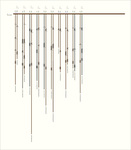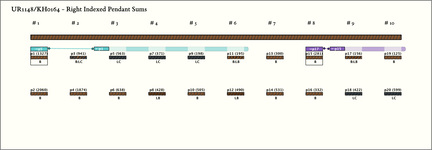| Notes: |
Ascher Databook Notes:
- UR1147-UR1149 are associated in that they were all designated by the same Museum number. They were acquired by the Museum in 1907 with provenance Ocucaje. For a comparison of them, see UR1147.
- By spacing, the khipu is separated into 3 parts. Part 1 is 2 pairs of pendants and parts 2 and 3 are eac h 4 pairs of pendants.
- The values in part 1 are the sums of values in parts 2 and 3. Assuming that the value of P2 is 2061 and the value of P13 is 379, with an exception of 1 in 1 digit, the first pair in part 1 are the sums, position by position, of the pairs in part 2, and the second pair in part 1 are the sums of the pairs in part 3, Namely:
\[ \sum\limits_{i=1}^{4} P_{2ij} = P_{11j}\;\;\;for\;j=(1,2) \]
\[ \sum\limits_{i=1}^{4} P_{3ij} = P_{12j}\;\;\;for\;j=(1,2) \]
where Pkij is the value of the pendant in the jth position of the ith group of the kth part.
- In all 10 pairs, the value of the second pendant is larger than the first. It is also larger than the first value in the next pair. Thus:
P2i > P2i-1 i=(1,...,10) and
P2i > P2i+1 i=(1,...,9)
where Pi is the value of the ith pendant on the khipu.
|



